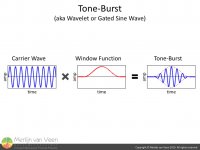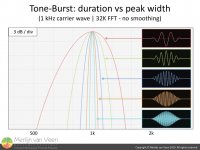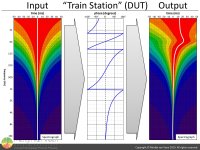I read that all ready I see errors " Because a sine wave with an amplitude envelope applied to it, stops being a pure tone and becomes a group of frequencies " - a group of frequencies implies multiple frequencies...amplitude does no modulate frequency let alone create, multiples....
It is a group of frequency....minor error if understood I guess
It is a group of frequency....minor error if understood I guess
Last edited:
So he says the picture to the right is a picture of frequencies ( a group of frequencies to be exact)....how many frequencies do you see?
Frequencies is the plural of frequency...
wiki-The human ear can recognize single sine waves as sounding clear because sine waves are representations of a single frequency
vs
Maybe he's talking about a tone burst in repetition? Or hes just messing up the terminologyBecause a sine wave with an amplitude envelope applied to it, stops being a pure tone and becomes a group of frequencies
Attachments
Last edited:
The answer is in the article that you have probably misread.
"A perfect impulse in the frequency domain (figure 2.1), i.e., a single, infinitely narrow spectral line, requires a pure tone (sine wave) of infinite duration (figure 2.2), i.e., from Big Bang till the end of time."
The tone burst you are hung up on is short and therefore broad in spectrum. It is frequencieS and not pure.
"A perfect impulse in the frequency domain (figure 2.1), i.e., a single, infinitely narrow spectral line, requires a pure tone (sine wave) of infinite duration (figure 2.2), i.e., from Big Bang till the end of time."
The tone burst you are hung up on is short and therefore broad in spectrum. It is frequencieS and not pure.
Come again? a sine wave is a pure tone....His quote says that a gated sine wave is now frequencies...thats not true
so you are saying that a short (gated) sine wave cannot contain a single frequency?The tone burst you are hung up on is short and therefore broad in spectrum
Last edited:
I mean its a misuse of words, I can read through it lol!!!
wait I found some more confusion...

Each of these on the right are supposed to be 1khz.....at first I thought the width had been expanded since the durations (width of each example) on the right side is identical....but some how the representation of the largest duration has the least amount of cycles in it....
I just don't know what is happening here....here does the longest duration tone burst have the lowest frequency when
Guess I'll just keep reading lol!!!
Correction, it is now a group of cycles, or even a group of amplitudes...
So in the video, the sound does appear to change frequency, perceptually...I'm not sure if that has anything to do with anything though. Maybe thats where this comes in?
wait I found some more confusion...
Each of these on the right are supposed to be 1khz.....at first I thought the width had been expanded since the durations (width of each example) on the right side is identical....but some how the representation of the largest duration has the least amount of cycles in it....
I just don't know what is happening here....here does the longest duration tone burst have the lowest frequency when
Figure 4 shows several amplitude-modulated carrier waves. In all instances, the carrier wave's frequency (1 kHz) is identical
Guess I'll just keep reading lol!!!
Looks like he labelled the above graph backwards, by what he says here....and in that case...the short burst are only broad because he (or the program displaying the results) stretched them out....there needs to be a time anvelope attached to the examples x axis, then this will be clearShort bursts result in broad frequency groups whereas long bursts result in narrow frequency groups
Notice that the width of the spectral peak which is no longer a pure tone but a now a group of frequencies
Correction, it is now a group of cycles, or even a group of amplitudes...
So in the video, the sound does appear to change frequency, perceptually...I'm not sure if that has anything to do with anything though. Maybe thats where this comes in?
The tone burst you are hung up on is short and therefore broad in spectrum
Attachments
Last edited:
Alright, now I see, I don't get it....but I see it.
Reading on....I feel like this is due to the distortion caused by group delay of the driver....when the cycle become too quick they (drivers group delay) distort the signal ie the distortion is revealed....otherwise it would not change...If we were to monitor the input signal it would likely reflect what I thought should have happened in the first place vs what the output actually was
Reading on....I feel like this is due to the distortion caused by group delay of the driver....when the cycle become too quick they (drivers group delay) distort the signal ie the distortion is revealed....otherwise it would not change...If we were to monitor the input signal it would likely reflect what I thought should have happened in the first place vs what the output actually was
Last edited:
I count 12 repetitions of the carrier wave modified by the time window function in the group of frequencies in the tone burst (aka wavelet or gated sine wave) in the picture to the right.So he says the picture to the right is a picture of frequencies ( a group of frequencies to be exact)....how many frequencies do you see?
Merlijn Van Veen wrote:
"Because a sine wave with an amplitude envelope applied to it, stops being a pure tone and becomes a group of frequencies which is where the group in group delay comes into play. From here on, I will refer to that sine wave as carrier wave."
"Where the group in group delay comes into play", the group of frequencies to be measured or compared is conceptually important in his article titled "Group Delay 101".
exactly the carrier wave only has one frequency- 1khz
But why does the sine wave stop becoming a pure a tone??? I suggested above that it is distortion from the speaker but I don't know for sure
Frequency is the amount of cycles/time.....how does amplitude duration manipulate that? In particular, from a single into multiple frequency? My suggestion is that the driver can't perform correctly in the small amount of time...maybe someone can explain? I bet the input doesn't match the output.
But why does the sine wave stop becoming a pure a tone??? I suggested above that it is distortion from the speaker but I don't know for sure
Frequency is the amount of cycles/time.....how does amplitude duration manipulate that? In particular, from a single into multiple frequency? My suggestion is that the driver can't perform correctly in the small amount of time...maybe someone can explain? I bet the input doesn't match the output.
pretty sure I just said that....Contrary to the original input signal, whose carrier wave's time period remained constant, the output signal's carrier wave has become somewhat of a swept sine wave whose time period changes over time.
Last edited:
Me
Amplitude envelope on a signal is the time from 0 amplitude to peak
Group delay is the measurement in time, from 0 amplitude to peak amplitude...yes or no?
Amplitude envelope refers to the changes in the amplitude of sound overtime...
Martin King
Admin
Amplitude envelope is not group delay.
I just reached the part of this article on Delay of the amplitude envelope time to get confused lol!!!
FWIW, here's my simpleminded way to view it, though whether technically correct?:
A railway train at rest or when running such that all coupled 'cars' are running as one = pure tone.
Starting or stopping, each coupling has a different delay until it's 'tight' or 'loose' = time delay.
As they each tighten up, increasing its sum totaled coupled length = group delay.
A railway train at rest or when running such that all coupled 'cars' are running as one = pure tone.
Starting or stopping, each coupling has a different delay until it's 'tight' or 'loose' = time delay.
As they each tighten up, increasing its sum totaled coupled length = group delay.
if they tighten doesnt the length decrease? I think the tight or loose means stretched apart of bunched together? If you stretch them, they are tight....if you bunch them together they are tight because the coupling only can move so far...So stretched or bunched works better imo. Unless I missed it here too lol
Camplo, my humble advice is your thinking needs to go deeper.
I would suggest you quit thinking about what drivers do, until you a much better grasp on the fundamentals of pure electrical signals.
I mean, after all, don't drivers respond to electrical signals...and how can we understand what drivers are doing until we understand the driving signal.....
This is the same advice i give to myself, btw....As i keep finding out ...i know nothing....
I would suggest you quit thinking about what drivers do, until you a much better grasp on the fundamentals of pure electrical signals.
I mean, after all, don't drivers respond to electrical signals...and how can we understand what drivers are doing until we understand the driving signal.....
This is the same advice i give to myself, btw....As i keep finding out ...i know nothing....
Well where I am at now is that the group delay chart is actually showing individual phase delay? I am not sure if thats true...I definitely have the right questions if you read back a few post...and no one has answers so far....you know what that means lol....
Otherwise...when it comes to electrical vs mechanical....the electrical signal can do things the diaphragm cannot...the electrical signal can instantly crest....no driver in the world exist that can do that. So when it comes down to the bass frequencies where the diaphragm must travel much farther...there's always going to be distortion in relation to the signal....If my suspicions are correct....the chart labelled group delay should be labelled phase delay....or maybe it is kinda like the frequency chart which displays spl.....that kinda makes sense...
What reading do you suggest for the understanding of the electrical?
Otherwise...when it comes to electrical vs mechanical....the electrical signal can do things the diaphragm cannot...the electrical signal can instantly crest....no driver in the world exist that can do that. So when it comes down to the bass frequencies where the diaphragm must travel much farther...there's always going to be distortion in relation to the signal....If my suspicions are correct....the chart labelled group delay should be labelled phase delay....or maybe it is kinda like the frequency chart which displays spl.....that kinda makes sense...
What reading do you suggest for the understanding of the electrical?
As they each tighten up, increasing its sum totaled coupled length = group delay.
I must be right about phase delay then....since there is no sum total in the group delay chart in HornResp only individual delays.....I've been arguing group delay as phase delay I bet....even worse is Martin probably knows this, and he's the type to give clues but not the answer lol
So far my theopries are playing out as correct according to the article
I said earlier that the electric signal does things the diaphragm cannot do. I said the input likely does not look like the output.
what the hell is a DUT....I know its meant to represent a driver here but whats a DUT
Oh its the "device under test"
So I really do know something? And I should have been saying phase delay this whole time...thats the best I've got so far......As well...the reason why a driver cannot play a tone burst that is too short is because of phase distortion as well....Unless someone disagrees....I have just leveled up.
Attachments
Last edited:
Camplo, no offense but you are not right about anything, phase delay as you see it, etc, and more etc, ... the fundamentals are still beyond your grasp.
(true with me too)
And really, Who cares about being right or wrong?
All i want is, to understand what is real, and how important is it to the best dang sound i ever heard.
What do You want?
(true with me too)
And really, Who cares about being right or wrong?
All i want is, to understand what is real, and how important is it to the best dang sound i ever heard.
What do You want?
are you sure I am not right?
It should be called "group of phase delay chart"...correct me where I am wrong
A group of frequencies is multiple....hence the name of the group delay chart..As they each tighten up, increasing its sum totaled coupled length = group delay..
Each individual Ms reading in the GD chart is phase delay for the corresponding frequencyThe group of frequencies is decomposed and its component frequencies' phases have been delayed (phase delay).
It should be called "group of phase delay chart"...correct me where I am wrong
Last edited:
Whoooooooosh....
sorry man, no time for this... was just trying to help you get out of your head....
sorry man, no time for this... was just trying to help you get out of your head....
Your article is proving to me that I understand the mechanics via this video ->
Audible sustain of Group Delay - YouTube
Either I said it right above, or not...but this video is showing exactly what I already believe...I just need to be able to say it correctly....which I probably have been the whole time, except for group delay vs phase delay.
If I don't "get it" then why do I hear what I expected to hear in this video...I keep telling people high group delay results in slow bass....in the video it is obvious that the delayed portion is late to the party....it is slooowwwwaaaaggghhhh
wiki -
Audible sustain of Group Delay - YouTube
Either I said it right above, or not...but this video is showing exactly what I already believe...I just need to be able to say it correctly....which I probably have been the whole time, except for group delay vs phase delay.
If I don't "get it" then why do I hear what I expected to hear in this video...I keep telling people high group delay results in slow bass....in the video it is obvious that the delayed portion is late to the party....it is slooowwwwaaaaggghhhh
wiki -
so why in the hell do we label it group delay....theres no group figure.... I am either getting something wrong or Group delay is an misnomerPhase delay, but not group delay, directly measures the device or system time delay of individual frequency components
Or phase delay and group delay are being used the same....group delay is the derivative of the phase vs. frequency.
Phase Delay vs. Group Delay – Marki Microwave RF & MicrowaveA variable length delay line, therefore, can only change the phase by changing the group delay. But by changing the group delay, you are changing the integral (slope) of the phase vs. frequency. This means that the phase change will be different at different frequencies
Last edited:
- Home
- Loudspeakers
- Multi-Way
- Is it possible to cover the whole spectrum, high SPL, low distortion with a 2-way?


